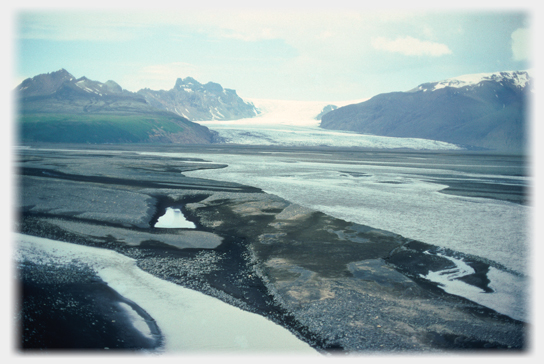
|
Wild Land
Wild land indeed; few would reject such a description of this part of south east Iceland. While we may agree over this photograph, and also that the meaning of wilderness and wild land resonates deeply with us, the idea remains elusive. Not the description of the 'wild', for there are many fine writers, not least in Britain, whose evocative lines easily transport us. Nor is there a dearth of fundamental ideas, ranging from Ghia to Deep Ecology, the supply is plentiful. Yet the attempts at providing a systematic ethic that links our emotional ties to nature, with an understanding of the metaphysics of our world, seems lacking. Richard Mabey helps us revel in his Chiltern beech woods, but are we clear why his spell works?
What is wild land and why does it matter? Why for instance should we 'protect' it and then what hubris lies in the notion of such protection? Questions abound. We are impelled to accept the picture above as being of wild land principally because of its inhospitability. Few people live near, and a lack of human impact seems vital to wilderness. But it is not primarily in lunar landscapes that wildness is encountered. We all feel we know wildness and crave it or fear it: it is nearby. It is not the distance from us that is crucial, but the sense of nature going about her business, and doing so independently of humans.
This dependence-independence dichotomy, as it relates to us, is central. Such processes as that of glacial movement have their own lives and yet, at the same time, engage us. The tension in this dichotomy showed starkly in the resistance to the enclosures particularly in the 1790s: fencing nature in, chaining her down, de-naturing nature, as good farming 'practices' were seen to be replacing working with an independent nature and allowing her to be herself.
This dichotomy is important in two respects. Immediately our culturally designed lives place fences to keep out the non-human, we construct our houses, ways of living, communications and understandings around our cultures. Animals and plants are driven out, and allowed back on leashes and in pots. “Out of the imagination of wilderness and the ignorance of indigenous presence came a false dichotomy: a wholly nonhuman nature and a wholly unnatural humanity. The latter was seen as a threat meaning that the former had to be protected as a place apart.”
Our areas of wilderness remind us of what our culture forces out: the contrast of organic space, to rectilinear cage; of flexibility and movement, to the concrete and the dead; and of development and change, to the atrophied and frozen. Nature is independently getting on with it, while we feel bound by a set of cultural chains.
There is also a more fundamental way that our independence from nature is problematic. While we live in culturally constructed worlds, those worlds are held in a framework that our minds construct. Not in the sense of conjuring from nothing, but in the sense of interpretation. The natural world and its objects among which we live, are not given to us ready made. Basic processes of our minds construct them, processes of which we are utterly unaware, simply because 'to be aware' is to be aware of the outcome of those processes. The processes create this nature we feel we encounter and which seems so essentially independent.
And here lies the heart of why wildness in nature matters. It echoes what cannot be comprehended: that which is uninterpreted, which is not part of human conceptualisation, and which has been called by some the 'noumena', and is profoundly independent of humans. From that world which we do not know, emerges, the known world of nature, wild nature seems to stand nearer the frontier of emergence than anything else we meet. Wild land echoes what is, when humans are not, and reminds us that although we create what we see, what we could ever see is never all that there is. That reminder gives us an inkling of an ethics based outside the human, one that we can all subscribe to because it is independent of humanity, one that makes everything, in its greater compass, equal.
References
- Sessions, George (Ed) (1995) 'Deep Ecology for the 21st Century' Shambhala, Boston.
- Maybe, Richard (1994) 'A Year's Turning in the Chilterns' in 'Landlocked: in Pursuit of the Wild'. Sinclair-Stevenson, London.
- Eliot Porter, Rebecca Solnit, John Rohrbach, and Jonathan Porter (2001) Eliot Porter: The Color of Wildness. Aperture, U.S.A. (p. 127)
10th July 2007 ~ 29th May 2015